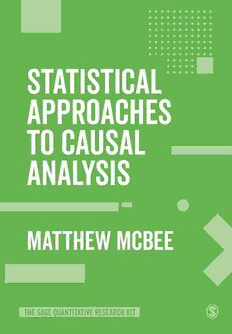Table Of ContentSTATISTICAL
APPROACHES
TO CAUSAL
ANALYSIS
Matthew McBee
THE SAGE QUANTITATIVE RESEARCH KIT
Statistical Approaches to Causal Analysis by Matthew McBee is the 10th volume in The
SAGE Quantitative Research Kit. This book can be used together with the other titles in the
Kit as a comprehensive guide to the process of doing quantitative research, but is equally
valuable on its own as a practical introduction to causal inference in quantitative research.
Editors of The SAGE Quantitative Research Kit:
Malcolm Williams – Cardiff University, UK
Richard D. Wiggins – UCL Social Research Institute, UK
D. Betsy McCoach – University of Connecticut, USA
Founding editor:
The late W. Paul Vogt – Illinois State University, USA
STATISTICAL
APPROACHES
TO CAUSAL
ANALYSIS
Matthew McBee
THE SAGE QUANTITATIVE RESEARCH KIT
SAGE Publications Ltd Matthew McBee 2021
1 Oliver’s Yard
55 City Road This volume published as part of The SAGE Quantitative
London EC1Y 1SP Research Kit (2021), edited by Malcolm Williams,
Richard D. Wiggins and D. Betsy McCoach.
SAGE Publications Inc.
Apart from any fair dealing for the purposes of research,
2455 Teller Road
private study, or criticism or review, as permitted under the
Thousand Oaks, California 91320
Copyright, Designs and Patents Act, 1988, this publication
may not be reproduced, stored or transmitted in any form,
SAGE Publications India Pvt Ltd
or by any means, without the prior permission in writing of
B 1/I 1 Mohan Cooperative Industrial Area
the publisher, or in the case of reprographic reproduction,
Mathura Road
in accordance with the terms of licences issued by
New Delhi 110 044
the Copyright Licensing Agency. Enquiries concerning
reproduction outside those terms should be sent to
SAGE Publications Asia-Pacific Pte Ltd
the publisher.
3 Church Street
#10-04 Samsung Hub
Singapore 049483
Library of Congress Control Number: 2020950514
Editor: Jai Seaman
Assistant editor: Charlotte Bush
British Library Cataloguing in Publication data
Production editor: Manmeet Kaur Tura
Copyeditor: QuADS Prepress Pvt Ltd
A catalogue record for this book is available from the
Proofreader: Elaine Leek
British Library
Indexer: Cathryn Pritchard
Marketing manager: Susheel Gokarakonda
Cover design: Shaun Mercier
Typeset by: C&M Digitals (P) Ltd, Chennai, India
Printed in the UK
ISBN 978-1-5264-2473-0
At SAGE, we take sustainability seriously. Most of our products are printed in the UK using responsibly sourced
papers and boards. When we print overseas, we ensure sustainable papers are used as measured by the PREPS
grading system. We undertake an annual audit to monitor our sustainability.
Dedication
This book is dedicated to my mother, Mary Kay McBee, who passed away before she
could see this book in print.
Contents
List of Figures and Tables xiii
About the Author xxiii
Acknowledgement xxv
Preface xxvii
1 Introduction 1
Internal Validity 2
External Validity 2
Threats to Validity 3
Randomisation 6
Non-Experimental Research 7
A Pragmatic Definition of Causation 9
Prediction Versus Explanation 10
Causal Inference Requires External Information 11
Estimation Versus Hypothesis Testing 13
Prerequisites 13
Notation 14
The R statistical programming environment 14
Installing and Using R and RStudio 16
R Packages 16
Structure of This Book 17
2 Conditioning 19
Simulated Data Set 21
Bias and Inconsistency 21
Obtaining a Biased Estimate of the Causal Effect 25
Covariate Adjustment 26
Visualising Covariate Adjustment 27
Covariate Adjustment Depends on Strong Assumptions 30
viii STATISTICAL APPROACHES TO CAUSAL ANALYSIS
Sample Selection 30
The Bias–Variance Trade-Off 32
Subclassification 33
Matching 35
Weighting 39
Computing the Weights 39
The Problem of Measurement 42
Classical Test Theory Model for Measurement Error 43
Reliability 44
Discussion 46
The ‘Curse of Dimensionality’ 47
3 Directed Acyclic Graphs 51
DAGs Are Not Path Models 53
DAG Terminology and Variable Roles 53
Exposure 54
Outcome 55
Mediator 55
Confounder 55
Proxy Confounder 56
Instrument 56
Competing Exposure 57
Collider 58
d-Separation, d-Connectedness and Statistical Independence 58
Conditioning 59
Conditioning on Colliders 61
Colliders and the Real World 62
Spurious Paths 64
Unobservables 69
Conditioning on Mediators 69
Criteria for Valid Causal Inference 72
Back-Door Criterion 72
Front-Door Criterion 73
Minimal and Sufficient Adjustment Sets 74
Simultaneous Estimation of Causal Effects 75
Measurement Error and DAGs 76
Using DAGitty 77
Practical Recommendations 81
contents ix
4 Rubin’s Causal Model and the Propensity Score 85
The Counterfactual Framework 86
Defining Causal Effects Under Rubin’s Causal Model 87
The Fundamental Problem of Causal Inference 88
Ignorability 90
Bias When Ignorability Does Not Exist 92
Baseline Bias 92
Differential Treatment Effect Bias 93
Conditional Ignorability 93
Conditional Treatment Effects 94
Example: Estimating ATT, ATU and ATE via Linear Regression 95
The Propensity Score 97
Approximating an Experiment 98
Simulated Data Set 101
Propensity Scores 101
Estimating Propensity Scores via Logistic Regression 102
Solving the Curse of Dimensionality 108
Propensity Score Estimation via Boosted Classification Trees 108
Comparing the Two Sets of Propensity Scores 115
Assumptions of Propensity Score Methods 116
Ignorability 116
Stable Unit Treatment Value Assumption 116
Positivity 117
5 Propensity Score Analysis 119
Simulated Data Set 120
Descriptive Statistics and Biased Treatment Effect Estimate 121
Obtaining a Biased Estimate of the Treatment Effect 121
Propensity Score Matching 124
Matching Algorithms 124
Estimating Treatment Effects with Matching 129
Example Analysis 129
Stratifying on the Propensity Score 131
Weighting with the propensity score 136
From Propensity Scores to Weights 139
Stabilised Weights and Truncated Weights 141
Example of an Analysis Using Propensity Score Weights 143
Doubly Robust Estimation 147

